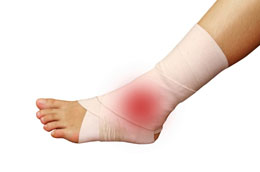There are different types of ankle sprains that can affect foot movement. Let us go into the details of the types, by going through the following health article.

My best friend is forever prone to ankle sprains. Walking, running, jogging and even when standing still; she manages to sprain her ankle. The doctor says she has a flat foot and this makes her prone to sprains in the ankle. We have been friends since the past 10 years, and in these many years she has managed to sprain her ankle about 8 times. Anyway, the point is, thanks to my dear friend, I have come to know there are different types and grades of ankle sprains. Laymen, like us, who do not understand medical jargon, feel all sprains are the same. However, this is not true and in the following paragraphs we shall learn a bit about its types in short.
Different Types of Ankle Sprains
Sprain in the ankle occurs when one suddenly twists their foot sideways. This sudden twist can occur when walking briskly, running, jogging, or walking on an uneven road and wearing heels. Just a single wrong step, and you end up with a sprain. It is the most common type of ankle injury addressed by orthopedics worldwide. The ligaments in the ankle that control excessive foot movement are stretched too far due to a sudden twist. This causes them to tear partially or completely. Thus, leading to the pain and discomfort. There are three different types of this sprain which are as follows:
Inversion Ankle Sprain
Lateral ligament sprain or inversion ankle sprain is one of the most common types. This sprain occurs when the sole of the foot turns inwards. When this happens the lateral ligaments, that is, outer ligaments are stretched too far. This type of sprain is common in people who play basketball, walk on uneven ground, or take a clumsy step forward. Also, people who have high arches and are supinates are more prone to inversion sprain.
Eversion Ankle Sprain
Medial ligament sprain or eversion sprain is one of the rare types. This sprain occurs when the ankle move the other way and the sole of the foot faces outward. This causes the internal ankle ligaments to tear. The deltoid ligament is the most common ligament to be affected by this type of sprain. The ankle 'rolls in' medially, and collapses, especially in cases of a fracture. This sprain usually affects gymnasts, weightlifters, people with flat arches and those who put more pressure on the inner side of the feet while walking.
High Ankle Sprain
The ligaments that support the tibia and fibula bones of the leg when injured lead to high ankle sprain. These sprains occur due to an outward force that occurs suddenly and causes the foot to twist. It commonly seen in people who play football, basketball and soccer. This is one of the least common type of sprain in the ankle.
Grades of Ankle Sprains
The severity of the sprain is classified in three grades. The amount of pain one experiences after a force is placed on the injured foot, helps one classify the types into different grades. Let us have a look at the grades that classify sprain in the ankle.
Grade I
Grade I is a mild sprain that occurs due to mild stretching of the ligament fibrils. It causes mild pain, a little swelling, mild joint stiffness, difficulty to jog and a slight joint instability. One can usually put some pressure on the leg and walk with a slight limp.
Grade 2
Grade 2 is a moderate sprain in the ankle. It occurs due to a partial tear of the ligament. It leads to some significant amount of swelling around the ankle. One may even observe bruising and suffer from moderate pain. It causes loss of motion to some extent, and one will have difficulty while walking.
Grade 3
The most severe type of ankle sprain is grade 3. Here, the ligament is completely torn, and the doctor observes gross instability if the ankle is pushed or pulled. It leads to severe pain, swelling, joint instability, total loss of motion, and walking becomes quite painful.
The sprained ankle treatment usually involves complete rest, ice compression, wearing a wrap that is snug, and elevation of the foot. The doctor will review your symptoms and, after classifying them under a particular grade, suggest a suitable ankle treatment plan.


 My best friend is forever prone to ankle sprains. Walking, running, jogging and even when standing still; she manages to sprain her ankle. The doctor says she has a flat foot and this makes her prone to sprains in the ankle. We have been friends since the past 10 years, and in these many years she has managed to sprain her ankle about 8 times. Anyway, the point is, thanks to my dear friend, I have come to know there are different types and grades of ankle sprains. Laymen, like us, who do not understand medical jargon, feel all sprains are the same. However, this is not true and in the following paragraphs we shall learn a bit about its types in short.
My best friend is forever prone to ankle sprains. Walking, running, jogging and even when standing still; she manages to sprain her ankle. The doctor says she has a flat foot and this makes her prone to sprains in the ankle. We have been friends since the past 10 years, and in these many years she has managed to sprain her ankle about 8 times. Anyway, the point is, thanks to my dear friend, I have come to know there are different types and grades of ankle sprains. Laymen, like us, who do not understand medical jargon, feel all sprains are the same. However, this is not true and in the following paragraphs we shall learn a bit about its types in short.